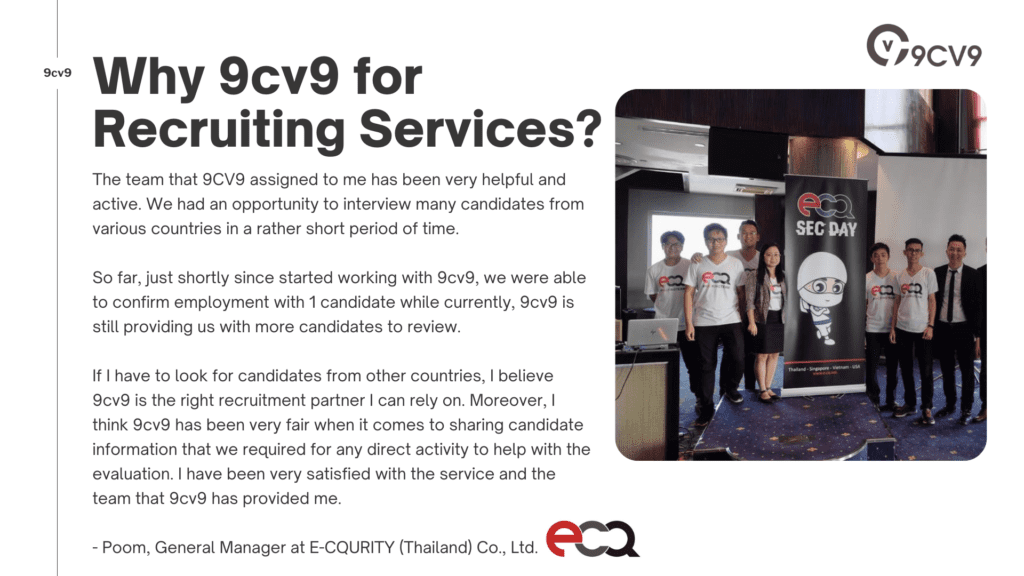Key Takeaways
- Localized Hiring Strategies: Leverage popular job platforms, recruitment agencies, and local networks tailored to East Asia’s unique job markets to attract top talent.
- Cultural and Legal Awareness: Navigate cultural nuances, legal requirements, and labor laws effectively to ensure seamless hiring and compliance in diverse East Asian countries.
- Technology-Driven Recruitment: Utilize AI and HR tech tools to streamline candidate sourcing, screening, and onboarding, staying competitive in East Asia’s evolving job landscape.
In 2025, the dynamic and diverse employment landscape in East Asia presents both unique opportunities and challenges for businesses looking to find and hire top talent.
As one of the world’s most economically powerful regions, East Asia is home to a highly educated, skilled, and technologically adept workforce.
However, understanding how to navigate the complexities of hiring in this region is crucial for companies that seek to expand, build diverse teams, and tap into the innovation driving global markets.
From rapidly evolving economies to shifting cultural dynamics, businesses must be well-prepared to attract the best candidates while overcoming challenges like tight competition for talent and navigating the region’s complex labor laws.
The key to successfully hiring employees in East Asia lies in understanding not only the region’s economic and social trends but also the specific hiring practices that differ from country to country.
For instance, Japan’s meticulous approach to work culture contrasts with the entrepreneurial spirit in Hong Kong, while China’s competitive job market requires a targeted strategy for attracting tech-savvy talent.
As East Asia continues to be a hub for global business, companies must adapt their recruitment strategies to fit the local demands of countries such as China, Japan, South Korea, Taiwan, and Hong Kong.
Whether you’re looking to hire for tech roles, skilled labor, or executive positions, your recruitment approach must align with the local culture and legal requirements of each market.
The fast-paced digital transformation in East Asia is further reshaping the hiring process, with AI-driven recruitment tools, online job platforms, and virtual interviewing becoming the norm.
Employers are increasingly turning to technology to streamline candidate sourcing, screening, and selection.
However, this technological shift also brings about new considerations, such as managing remote teams and adopting AI tools effectively while maintaining a human touch in the recruitment process.
In this guide, we will explore comprehensive strategies to help businesses navigate the East Asian job market in 2025.
From understanding cultural nuances and legal requirements to leveraging cutting-edge recruitment technology, we will provide insights on how to source, attract, and hire top talent across East Asia.
Additionally, we will discuss best practices for interviewing, onboarding, and retaining employees to ensure that your new hires thrive in this unique and ever-evolving region.
By the end of this article, you will have a thorough understanding of the essential steps needed to build a successful workforce in East Asia—one that is equipped to drive innovation and growth in the coming years.
Before we venture further into this article, we would like to share who we are and what we do.
About 9cv9
9cv9 is a business tech startup based in Singapore and Asia, with a strong presence all over the world.
With over nine years of startup and business experience, and being highly involved in connecting with thousands of companies and startups, the 9cv9 team has listed some important learning points in this overview of How to Find and Hire Employees in East Asia in 2025.
If your company needs recruitment and headhunting services to hire top-quality employees, you can use 9cv9 headhunting and recruitment services to hire top talents and candidates. Find out more here, or send over an email to [email protected].
Or just post 1 free job posting here at 9cv9 Hiring Portal in under 10 minutes.
How to Find and Hire Employees in East Asia in 2025
- Understanding the East Asian Job Market in 2025
- Best Strategies to Find Employees in East Asia
- Understanding Cultural and Legal Factors in Hiring
- Leveraging Technology and AI for Recruitment
- Interviewing and Onboarding Employees in East Asia
- Salary Expectations and Employee Retention Strategies
1. Understanding the East Asian Job Market in 2025
As businesses look to expand their footprint in East Asia, understanding the intricate dynamics of the region’s job market is essential for successful recruitment. The East Asian job market in 2025 is characterized by rapid technological advancements, shifting demographic trends, and evolving employment norms. To hire effectively in East Asia, companies need to adapt their strategies to the specific economic, social, and cultural characteristics of each country.
Here’s a comprehensive breakdown of the key factors that are shaping the East Asian job market in 2025:
Economic Growth and Employment Trends
- Economic Powerhouses: East Asia remains one of the world’s largest economic regions, with China, Japan, South Korea, and Taiwan driving much of the region’s growth.
- China: With its robust manufacturing sector and burgeoning tech industry, China’s job market continues to grow, particularly in sectors like AI, e-commerce, and green energy.
- Japan: Japan’s economy has diversified, with strong emphasis on technology, robotics, and healthcare, while grappling with an aging population and declining workforce.
- South Korea: As a leader in technology and innovation, South Korea’s labor market demands skilled professionals in fields like AI, semiconductor production, and digital media.
- Taiwan: Taiwan is a tech hub, particularly for the semiconductor industry, which creates demand for engineers and technical specialists.
- Sectors with High Demand: The most in-demand industries in East Asia in 2025 are technology, finance, healthcare, and green energy.
- Technology: There is an ever-increasing demand for software developers, AI engineers, and cybersecurity professionals, especially in China, South Korea, and Japan.
- Finance: With economic growth in key markets like China, Hong Kong, and Singapore, there is a growing need for financial analysts, investment bankers, and compliance officers.
- Healthcare: Aging populations across East Asia are driving a demand for healthcare professionals, such as doctors, nurses, and caregivers.
- Green Energy: As nations strive to meet sustainability goals, sectors like renewable energy and environmental consulting are rapidly expanding, especially in China and Japan.
Demographic Shifts Affecting Talent Availability
- Aging Population: Many East Asian countries face demographic challenges, with a significant portion of their population aging. This has direct implications for the workforce and talent pool.
- Japan: The aging population in Japan is particularly pronounced, with a rapidly shrinking working-age population, creating a talent shortage in key sectors.
- South Korea: South Korea also faces similar challenges, leading to a rise in government incentives for increasing birth rates and encouraging immigration.
- China: While China has a large workforce, the one-child policy has resulted in a shrinking young population, leading to long-term workforce constraints in the future.
- Rise of the Millennial and Gen Z Workforce: Younger generations in East Asia are more tech-savvy, globally connected, and entrepreneurial than previous generations.
- Shift in Values: These younger workers are more likely to prioritize work-life balance, flexible working conditions, and meaningful work over traditional employment benefits.
- Tech Adaptation: Millennials and Gen Z workers are increasingly attracted to industries involving technology, innovation, and digital transformation. Companies looking to attract this demographic should emphasize their tech capabilities, flexibility, and opportunities for growth.
Impact of Technology and Automation
- AI and Automation: East Asia’s job market is heavily influenced by the rise of AI and automation technologies, transforming industries and the nature of employment.
- Manufacturing and Robotics: Countries like Japan and South Korea are investing heavily in robotics and automation, reshaping the manufacturing sector. While this reduces the demand for manual labor, it increases the demand for skilled workers in engineering, machine learning, and robotics.
- Tech-Focused Jobs: In line with the global tech boom, East Asia’s workforce is rapidly adopting AI, data analytics, and cloud computing, creating a strong demand for digital skills across various sectors.
- Displacement and Reskilling: As automation takes over routine tasks, there is a growing need for reskilling programs to equip workers with new skills, particularly in AI, digital marketing, and cybersecurity.
- Remote Work and Digital Nomadism: The rise of remote work, accelerated by the pandemic, has become a significant trend in East Asia.
- Increased Remote Opportunities: Companies in cities like Hong Kong, Seoul, and Singapore are increasingly offering flexible work arrangements, attracting talent from across the region and globally.
- Digital Nomads: East Asia is witnessing the rise of digital nomads, particularly in countries like South Korea, which is becoming a popular base for remote workers thanks to its fast internet and vibrant expat communities.
Talent Mobility and Migration Trends
- Talent Mobility: Countries like Singapore, Hong Kong, and Japan have been successful in attracting international talent through visa schemes and global talent programs.
- Singapore: Known for its pro-business policies, Singapore remains a hub for international talent, especially in finance, tech, and healthcare.
- Hong Kong: Despite political uncertainties, Hong Kong continues to be a magnet for professionals from around the world, especially in finance and trading.
- Japan: Japan has been slowly opening up to foreign workers, especially in sectors like manufacturing, IT, and caregiving, to combat its demographic challenges.
- Inbound Migration: In response to aging populations and the demand for skilled labor, East Asian nations are increasingly opening their doors to foreign workers.
- China: While China has a more closed approach compared to other East Asian countries, it is gradually easing restrictions for skilled foreign workers in fields like technology and research.
- South Korea: South Korea is actively encouraging immigration for skilled workers, particularly in IT and healthcare, through specialized visa programs.
Regional Variations in Employment Practices
- China: China’s job market is highly competitive, especially in cities like Beijing, Shanghai, and Shenzhen. Companies must navigate a complex regulatory environment and stay updated on changes in employment laws and policies.
- Contractual Flexibility: In major cities, short-term contracts and temporary positions are increasingly popular, especially in the gig economy.
- Japan: Japan’s traditional employment culture remains, with many workers preferring lifetime employment in large corporations. However, there is a growing trend towards freelance work and contract-based positions, especially in tech and creative industries.
- South Korea: South Korea’s job market is marked by a high level of competition for top-tier positions, particularly in technology and finance. Work culture is hierarchical, with significant importance placed on education and credentials.
- Taiwan: Taiwan has a relatively open and flexible labor market. Its tech-driven economy fosters a demand for workers with skills in innovation, research, and development.
- Hong Kong: Hong Kong’s job market is highly international, with many multinational corporations headquartered there. It remains an attractive location for talent in finance, law, and business services.
Conclusion
The East Asian job market in 2025 presents significant opportunities for businesses that are willing to adapt their recruitment strategies to the region’s unique economic, demographic, and technological landscapes. As the demand for skilled professionals rises across industries, companies will need to be agile, leveraging the latest recruitment tools and staying attuned to the cultural, legal, and social factors that influence hiring. By understanding the complexities of the region’s job market, businesses can better position themselves to attract top talent and remain competitive in an increasingly globalized world.
2. Best Strategies to Find Employees in East Asia
Finding and hiring the right employees in East Asia in 2025 requires a multifaceted approach that combines local insights, digital tools, and strategic outreach. The region’s diverse cultures, technological advancements, and economic trends necessitate tailored recruitment strategies to attract and retain the best talent. Whether you’re looking to fill positions in Japan, China, South Korea, Taiwan, or Hong Kong, your recruitment efforts must consider the specific preferences and expectations of candidates in each market. Below are the best strategies to find employees in East Asia in 2025.
1. Leverage Online Job Portals and Recruitment Platforms
- Target Local Job Boards: Using region-specific job platforms is crucial to reaching local candidates effectively. Many countries in East Asia have their own leading job portals.
- China: Websites like 51Job and Zhaopin dominate the local recruitment space and are perfect for reaching professionals in various sectors, particularly in technology, finance, and manufacturing.
- Japan: Rikunabi and MyNavi are top job boards used by job seekers and employers. They focus heavily on graduate hiring but are also effective for mid-career professionals.
- South Korea: Platforms like JobKorea and Saramin are ideal for reaching young, tech-savvy professionals.
- Hong Kong: JobsDB and CTgoodjobs are popular platforms for reaching a diverse pool of candidates in industries like finance, business, and tech.
- Taiwan: 104 Job Bank is one of Taiwan’s most popular job portals, widely used by companies looking to fill tech and engineering positions.
- Global Recruitment Platforms: In addition to local job boards, global platforms like LinkedIn, Indeed, and Glassdoor are commonly used across East Asia to connect with international talent and promote employer branding.
- LinkedIn remains a popular platform for professional networking in East Asia, particularly in China, South Korea, and Hong Kong, and is crucial for hiring mid-to-senior level professionals.
9cv9: The Top Job Portal in East Asia in 2025
In the ever-evolving job market of East Asia, where competition is fierce and talent is abundant, 9cv9 emerges as the leading recruitment platform of choice for employers and job seekers alike.
As businesses face the challenge of finding the right talent amidst rapid economic growth, shifting market trends, and diverse cultural landscapes, 9cv9 stands out as the ultimate solution for efficient, streamlined hiring in 2025.

Why 9cv9 Is the Top Job Portal in East Asia
1. Comprehensive Talent Pool
9cv9 connects employers with a vast network of highly qualified professionals across East Asia. Whether you’re looking for tech innovators in Singapore, engineers in Japan, or marketing experts in China, 9cv9 offers a diverse talent pool that spans industries and specialties, ensuring you find the best fit for your business needs.
2. Advanced Search and Filtering Options
Gone are the days of sifting through hundreds of irrelevant applications. 9cv9’s intuitive search algorithms and filtering options allow businesses to narrow down candidates based on specific skills, experience, location, and qualifications, streamlining the hiring process.
3. Culturally Attuned Solutions
With a deep understanding of East Asia’s cultural nuances, 9cv9 tailors its platform to fit the region’s unique recruitment dynamics. This includes localized job listings, culturally sensitive communication features, and support for various languages, ensuring a seamless hiring experience for both employers and job seekers.
4. AI-Driven Job Matching
In 2025, leveraging AI technology is essential for staying competitive in the job market. 9cv9 utilizes AI-powered job matching, ensuring that companies are paired with candidates who meet their exact requirements. By analyzing job descriptions and resumes, the platform predicts the best matches, saving time and improving hiring accuracy.
5. Seamless Job Posting and Application Process
For employers, posting job listings on 9cv9 is quick and easy, and the platform provides powerful tools for managing applications efficiently. Job seekers can apply directly through the site, allowing employers to assess applicants without delays. Additionally, businesses can track the progress of their recruitment campaigns and gain insights into their hiring effectiveness.
6. Strong Focus on Employer Branding
In a region where top talent is often swayed by a company’s reputation, 9cv9 helps businesses showcase their brand effectively. Employers can create detailed company profiles, share employee testimonials, and highlight their workplace culture, which helps attract candidates who align with their values.
7. High-Impact Analytics and Insights
9cv9 provides powerful analytics tools to help businesses optimize their recruitment efforts. Employers can track candidate engagement, monitor the success of job postings, and make data-driven decisions to improve their hiring strategies.
Why Choose 9cv9 for Hiring in East Asia?
In 2025, 9cv9 stands as a beacon for both employers and job seekers in East Asia. Whether you’re looking to scale your business in a competitive market or seeking new career opportunities in one of the world’s most dynamic regions, 9cv9 offers unmatched resources, advanced technology, and tailored solutions to help you succeed.
Employers trust 9cv9 to help them connect with the right talent, while job seekers turn to the platform for job opportunities with top companies across East Asia. With its extensive reach, sophisticated technology, and cultural sensitivity, 9cv9 is the top choice for recruitment in East Asia, making it the ultimate destination for all your hiring needs in 2025.

2. Utilize AI-Powered Recruitment Tools and Platforms
- AI-Driven Recruiting: Automation and artificial intelligence are revolutionizing the recruitment process in East Asia. AI-based tools are used to streamline candidate sourcing, reduce time-to-hire, and ensure a more objective selection process.
- Applicant Tracking Systems (ATS): Platforms like SmartRecruiters, Workday, and Greenhouseintegrate AI to help employers filter candidates, screen resumes, and manage the recruitment pipeline efficiently.
- AI Assessment Tools: Tools like HireVue use AI to analyze candidate video interviews, evaluating facial expressions, tone of voice, and keywords to assess qualifications and cultural fit.
- AI-Powered Job Matching: Platforms like SeekOut and HireEZ use AI to source, rank, and match candidates from diverse talent pools, streamlining the hiring process and identifying top candidates that may have been overlooked through traditional methods.
- Example: A company in South Korea looking to hire a software engineer may use an AI-powered platform to match job descriptions with a wide pool of tech professionals, saving time in sourcing quality candidates.
3. Focus on Building an Attractive Employer Brand
- Tailored Employer Value Proposition (EVP): To attract top talent in East Asia, companies must emphasize their Employer Value Proposition (EVP)—the unique benefits and opportunities they offer to employees.
- Work-Life Balance: Given the importance placed on work-life balance in countries like Japan and South Korea, employers should highlight flexible working hours, remote work options, and employee wellness programs.
- Growth and Development: East Asian candidates, especially in places like Hong Kong and Taiwan, value opportunities for career growth. Showcase mentoring programs, leadership training, and clear career progression pathways.
- Sustainability and Innovation: In China and Japan, many younger workers are drawn to companies that prioritize environmental sustainability and cutting-edge innovation. Companies should highlight their sustainability initiatives, research and development efforts, and commitment to corporate social responsibility (CSR).
- Social Media and Employer Branding: In 2025, social media is a powerful tool for employer branding in East Asia.
- WeChat and Weibo in China, LINE in Japan and Taiwan, and KakaoTalk in South Korea are widely used for company promotion and direct communication with candidates.
- Regularly post content about company culture, employee stories, and innovative projects to engage potential hires.
4. Partner with Recruitment Agencies Specialized in East Asia
- Expert Agencies: In East Asia, many companies turn to recruitment agencies with local expertise to help them find and hire talent faster. These agencies provide access to a wide network of pre-vetted candidates and offer deep knowledge of local labor laws and market trends.
- China: Agencies like 9cv9 and Robert Walters are well-established and have a deep understanding of China’s corporate landscape, which can help navigate the complex hiring process.
- Japan: In Japan, recruitment firms like JAC Recruitment specialize in matching candidates with multinational companies in sectors such as IT, engineering, and finance.
- South Korea: HRnetOne and Hays Korea are trusted agencies in South Korea, particularly useful for high-demand sectors like technology and finance.
- Headhunting Services: For senior-level positions, consider using headhunting services that specialize in finding executive talent across East Asia.
- These services often have direct connections with top professionals, ensuring faster placements and a higher success rate in filling senior roles.
9cv9: The Premier Recruitment Agency in East Asia in 2025
In 2025, East Asia remains one of the most competitive regions for talent acquisition. Whether you’re expanding your business or scaling operations, finding the right professionals can be a daunting task.
That’s where 9cv9 comes in – the top recruitment agency in East Asia, committed to connecting you with the best talent across the region.
With a powerful mix of technology, expertise, and localized services, 9cv9 ensures that you make the best hiring decisions quickly and effectively.

Why Choose 9cv9 as Your Recruitment Partner?
1. Wide Talent Network Across East Asia
At 9cv9, we understand that talent knows no borders. Our extensive database includes skilled professionals from China, Japan, South Korea, Singapore, and beyond. From tech experts to marketing professionals, our platform offers access to a diverse pool of talent, making it easier for businesses to find candidates who perfectly match their needs.
2. Tailored Recruitment Solutions for Every Industry
9cv9 doesn’t offer a one-size-fits-all approach. Our team specializes in various industries such as technology, healthcare, finance, manufacturing, and more. Whether you’re a startup looking for your first employee or a multinational corporation scaling up, 9cv9 customizes recruitment strategies to align with your industry’s unique requirements.
3. AI-Powered Candidate Matching
Leverage cutting-edge AI technology with 9cv9. Our advanced AI matching algorithms analyze both job descriptions and candidate profiles to find the best-fit talent faster than ever before. This technology allows us to filter out irrelevant applications and provide you with candidates who truly meet your needs.
4. Deep Understanding of Local Markets
East Asia is a region rich in diversity, each country having its own unique set of cultural and legal considerations. 9cv9’s team is locally embedded and offers a deep understanding of these nuances, ensuring your recruitment process is both culturally and legally compliant. We help navigate local employment laws, ensuring that all hires meet legal and regulatory standards.
5. Streamlined Recruitment Process
From posting job listings to interviewing candidates, 9cv9 offers an easy-to-use platform that streamlines every step of your recruitment process. With integrated applicant tracking systems, you can manage all your hiring activities in one place, making the process faster and more efficient.
6. Employer Branding Support
In today’s competitive job market, employer branding is key. 9cv9 helps you enhance your company’s reputation and attract top-tier candidates by offering features to showcase your company culture, employee benefits, and career growth opportunities. We help you communicate what makes your company a great place to work.
7. Personalized Talent Search
If you’re looking for niche skills or highly experienced professionals, 9cv9 offers a personalized talent search to help you find the perfect candidate. Our recruitment experts actively source talent through multiple channels, including passive candidates, ensuring you don’t miss out on high-quality professionals.
8. Data-Driven Insights for Smarter Hiring
With 9cv9’s advanced analytics tools, you can track the performance of your recruitment campaigns, monitor candidate engagement, and make informed decisions. These insights help you refine your hiring process, ensuring better outcomes and faster placements.

Why 9cv9 is the Right Choice for Your Recruitment Needs in 2025
As East Asia continues to grow and evolve, having a reliable recruitment partner is essential.
9cv9 stands out as the leading recruitment agency in the region, offering an unmatched combination of technological innovation, deep local expertise, and a strong commitment to client success.
Whether you’re looking to hire top tech talent, build out your sales team, or expand your workforce across borders, 9cv9 has the tools, network, and knowledge to support your hiring needs in 2025.
Choosing 9cv9 means access to the region’s most skilled professionals, cutting-edge AI tools, and recruitment services tailored to your specific business goals.
With 9cv9 by your side, your hiring journey in East Asia will be faster, smoother, and more successful than ever before.
5. Engage in Campus Recruitment and Internship Programs
- University Partnerships: To attract fresh talent, consider engaging in campus recruitment efforts across East Asia’s top universities.
- China: Universities like Tsinghua University and Peking University produce a large pool of highly educated graduates, particularly in STEM fields.
- Japan: Leading institutions like The University of Tokyo and Kyoto University offer a great pipeline for top candidates, especially in the fields of engineering, research, and technology.
- South Korea: In South Korea, KAIST and POSTECH are renowned for producing skilled talent, particularly in science, technology, and engineering.
- Internship Programs: Offering internship opportunities is an excellent way to identify high-potential talent early. Interns often become full-time employees after completing their programs.
- Taiwan: Companies that establish strong internship programs with universities such as National Taiwan University (NTU) benefit from gaining access to a pool of young, motivated candidates.
6. Consider Talent from the Gig Economy and Freelancers
- Gig Economy: The rise of the gig economy across East Asia has reshaped how companies find talent, especially in industries like tech, marketing, and design.
- China: Platforms like Baidu and Freelancer.com are popular among freelancers in China, where companies are increasingly hiring talent for short-term projects and contract work.
- Japan: Japan has also seen a rise in freelance workers, particularly in IT, design, and content creation. Freelance platforms like Lancers are essential tools for employers seeking temporary or project-based talent.
- Freelance Platforms: International platforms like Upwork, Toptal, and Fiverr are widely used to hire remote workers in East Asia. These platforms offer access to a global talent pool, ideal for companies seeking specialized skills that may not be readily available locally.
7. Host Virtual Job Fairs and Networking Events
- Virtual Recruitment Events: Hosting online career fairs and networking events is a cost-effective way to meet a large number of candidates from different countries in East Asia.
- These events enable companies to interact with candidates directly, hold informational sessions about company culture, and answer questions in real-time.
- Platforms like Brazen and vFairs can help companies organize and host virtual job fairs for specific countries or sectors.
- Industry Conferences and Meetups: Participating in or sponsoring tech and industry-specific events in East Asia can also be a great way to connect with potential employees.
- Tech Conferences: For example, participating in conferences like TechCrunch China or DevConf Japancan help employers network with professionals in tech fields.
- Job Expos and Forums: Countries like Hong Kong and South Korea often host large career fairs where employers can meet candidates face-to-face and recruit top talent in real-time.
Conclusion
In 2025, finding and hiring employees in East Asia requires a combination of understanding regional preferences, leveraging the right tools, and adapting to the fast-evolving recruitment landscape. By focusing on tailored approaches that incorporate digital platforms, AI recruitment tools, strong employer branding, and effective outreach strategies, businesses can successfully attract and hire top talent. Additionally, integrating flexible work arrangements and tapping into the gig economy can further broaden the pool of skilled professionals available. Following these strategies will not only help companies find the best candidates but also ensure they are prepared to compete in the rapidly evolving East Asian job market.
3. Understanding Cultural and Legal Factors in Hiring
Hiring in East Asia in 2025 requires a nuanced understanding of the region’s diverse cultural norms and complex legal frameworks. Each country in East Asia has its unique blend of traditions, societal expectations, and regulatory environments that significantly impact recruitment strategies. Employers must navigate these factors to attract talent effectively and maintain compliance with labor laws. Below is an in-depth analysis of the cultural and legal aspects to consider, with relevant examples where applicable.
1. Cultural Factors in Hiring Across East Asia
Cultural nuances play a crucial role in shaping recruitment strategies in East Asia. Employers must adapt their approach to respect and leverage these differences.
a. Importance of Hierarchy and Respect
- Confucian Influence: Many East Asian countries, including China, Japan, and South Korea, are influenced by Confucian values, which emphasize respect for hierarchy and authority.
- Example: In Japan and South Korea, addressing senior professionals with proper honorifics and showing deference during interviews is critical to building trust and rapport.
- Job titles and the perceived seniority of the interviewer can significantly impact candidate engagement.
- Seniority-Based Decision-Making: Candidates may expect clear career progression tied to tenure rather than performance alone.
- Example: In traditional Japanese corporations, candidates often prefer roles with guaranteed stability and seniority-based promotions.
b. Emphasis on Teamwork and Collaboration
- Collective Mindset: In East Asia, the emphasis on group harmony and teamwork often outweighs individual achievements.
- Employers should assess not only technical skills but also a candidate’s ability to collaborate and integrate within teams.
- Example: In China, team-based interview assessments, such as case studies or group problem-solving tasks, are common to evaluate a candidate’s collaborative abilities.
c. Work Ethic and Loyalty
- Long-Term Commitment: Candidates in East Asia often value job stability and expect employers to demonstrate a commitment to their development.
- Highlight long-term benefits, such as training programs, mentorship opportunities, and pension plans.
- Example: South Korean professionals tend to value chaebol companies (large family-owned conglomerates) for their perceived stability and lifetime employment promises.
d. Language and Communication
- Bilingual Proficiency: While English is often a required skill for multinational companies, many candidates prefer communication in their native language during interviews and onboarding.
- Example: Taiwanese candidates may appreciate bilingual job postings in Mandarin and English to ensure clarity about job roles and expectations.
- Non-Verbal Communication: In cultures like Japan, non-verbal cues such as body language and silence during negotiations can convey respect and thoughtfulness.
2. Legal Factors in Hiring Across East Asia
Each country in East Asia has distinct legal frameworks governing employment. Adhering to these laws is crucial for building trust and avoiding penalties.
a. Employment Contracts and Labor Laws
- Mandatory Employment Contracts: Most East Asian countries require detailed written contracts specifying salary, work hours, benefits, and termination clauses.
- China: Employment contracts are legally binding, and failure to issue one within a month of hiring can result in penalties.
- Japan: Contracts must clearly outline working conditions, particularly for non-regular employees (e.g., part-time and contract workers).
- Probationary Periods: Probation terms vary by country and are subject to legal restrictions.
- Example: In South Korea, probation periods generally last three months and must comply with minimum wage and social insurance laws.
b. Working Hours and Overtime Regulations
- Standard Work Hours: Across East Asia, labor laws set limits on standard working hours and require additional pay for overtime.
- China: The standard workweek is 40 hours, with overtime capped at three hours per day and a legal limit of 36 hours per month.
- South Korea: The government enforces a 52-hour workweek limit, including overtime, to promote work-life balance.
- Overtime Compensation: Employers must pay overtime rates, typically 1.5 to 2 times the normal hourly wage, depending on the country.
- Example: Japanese companies are closely monitored for compliance with overtime laws under the “Work Style Reform Act.”
c. Hiring Foreign Employees
- Visa Requirements: Hiring foreign talent requires compliance with visa and work permit regulations unique to each country.
- China: Work visas (Z visas) require proof of educational qualifications and a valid employment contract.
- Japan: The “Highly Skilled Professional Visa” prioritizes foreign workers with expertise in technology, academia, and business management.
- Quotas and Restrictions: Some countries impose quotas on the number of foreign employees a company can hire.
- Example: South Korea has specific visa categories like the E-7 (specialty occupations) and restricts hiring based on industry needs and company size.
d. Non-Discrimination Laws
- Equal Opportunity Hiring: Discrimination based on gender, age, ethnicity, or disability is prohibited in most East Asian countries.
- Japan: Companies must adhere to the Equal Employment Opportunity Law, which promotes gender equality in the workplace.
- China: Anti-discrimination laws mandate fair hiring practices, but enforcement may vary by region.
- Examples of Non-Compliance: In South Korea, job ads explicitly stating age or gender preferences are discouraged, with penalties imposed on violators.
e. Social Security and Benefits
- Mandatory Contributions: Employers must contribute to social security schemes, including health insurance, pensions, and unemployment insurance.
- China: Contributions to the “Five Insurances and One Housing Fund” are mandatory for all employees.
- Taiwan: Employers must enroll workers in the National Health Insurance (NHI) system.
- Parental Leave: Maternity and paternity leave entitlements vary but are legally protected across East Asia.
- Example: South Korea offers 90 days of paid maternity leave, with part of the cost covered by the government.
3. Balancing Cultural Sensitivity with Legal Compliance
Employers must integrate cultural understanding with adherence to labor laws to create a balanced and effective hiring process.
a. Tailored Job Descriptions
- Avoiding Legal Pitfalls: Ensure job descriptions comply with anti-discrimination laws and accurately reflect the role.
- Example: A job listing in Japan should avoid specifying preferred gender or age, aligning with the Equal Employment Opportunity Law.
- Culturally Relevant Language: Use culturally appropriate terms and phrases to attract candidates.
- Example: In South Korea, emphasizing “family-like company culture” resonates well with candidates.
b. Training and Awareness for HR Teams
- Cultural Sensitivity Training: Equip HR teams with knowledge of regional customs and practices.
- Example: Training on the significance of “guanxi” (relationship-building) in China can improve recruitment outcomes.
- Legal Compliance Workshops: Regular workshops on labor laws help avoid unintentional violations.
c. Partnering with Local Experts
- Legal Consultants: Engage local legal experts to navigate complex employment regulations.
- Example: Consulting with a labor law specialist in Taiwan ensures compliance with evolving employment rules.
- Cultural Advisors: Employ cultural consultants to refine hiring practices and align them with local expectations.
Conclusion
Understanding cultural and legal factors is indispensable for hiring successfully in East Asia in 2025. From respecting Confucian values and teamwork dynamics to adhering to stringent labor laws and visa regulations, employers must adopt a thoughtful and well-informed approach. By balancing cultural sensitivity with legal compliance, businesses can build a strong, diverse workforce while fostering trust and long-term relationships with employees in the region.
4. Leveraging Technology and AI for Recruitment
The rapid advancement of technology and artificial intelligence (AI) has transformed the recruitment landscape globally, and East Asia is no exception. Companies in the region are increasingly adopting innovative tools and AI-powered platforms to streamline their hiring processes, enhance candidate experiences, and improve decision-making. Below is a comprehensive exploration of how businesses in East Asia can effectively leverage technology and AI for recruitment in 2025.
1. The Role of AI in Streamlining Recruitment Processes
AI tools are reshaping the way organizations approach hiring by automating repetitive tasks, enhancing accuracy, and enabling data-driven decision-making.
a. Resume Screening and Candidate Matching
- Automated Resume Parsing: AI-powered systems can scan and analyze resumes at scale, identifying top candidates based on predefined criteria.
- Example: In South Korea, tech companies use AI tools to filter through thousands of applicants for engineering roles, saving significant time during the hiring season.
- Skill-Based Matching: AI algorithms match candidate skills with job requirements to ensure alignment.
- Example: Platforms like China’s Boss Zhipin use AI to recommend candidates for roles based on skillsets and job history.
b. Chatbots for Candidate Engagement
- 24/7 Availability: AI-driven chatbots answer candidate queries, schedule interviews, and provide application updates.
- Example: Japanese firms integrate chatbots like ChatGPT for recruitment, offering multilingual support to international candidates.
- Improved Candidate Experience: Chatbots ensure faster responses, leading to higher satisfaction rates among applicants.
- Example: Companies in Taiwan have reported a 30% increase in candidate retention during the application process after deploying AI chatbots.
c. Predictive Analytics
- Hiring Success Predictions: AI analyzes past hiring data to predict a candidate’s likelihood of success in a specific role.
- Example: In China, predictive analytics tools evaluate cultural fit and potential employee turnover, ensuring long-term hiring success.
- Diversity and Inclusion: AI helps organizations identify biases in hiring processes and promote a more inclusive workforce.
- Example: South Korean companies leverage AI to create unbiased algorithms that ensure equal opportunities for women in STEM fields.
2. Using Technology for Remote Recruitment
Remote hiring has become a cornerstone of modern recruitment strategies, particularly in East Asia’s tech-savvy workforce.
a. Virtual Interview Platforms
- AI-Assisted Interviews: Tools analyze facial expressions, tone of voice, and word choice during virtual interviews to assess soft skills.
- Example: Japanese corporations use platforms like HireVue to evaluate candidates’ communication and teamwork abilities.
- Convenience for Global Talent Acquisition: Virtual interviews enable companies to attract talent across East Asia without logistical barriers.
- Example: A startup in Singapore successfully hired a software developer in Taiwan using AI-enhanced video interviews.
b. Gamification in Recruitment
- Interactive Assessments: Gamified platforms test problem-solving, critical thinking, and creativity in engaging formats.
- Example: Chinese e-commerce giants integrate gamified coding challenges into their hiring processes for tech roles.
- Improved Candidate Engagement: Games make recruitment enjoyable and reduce anxiety among candidates.
- Example: In South Korea, gamified personality tests are widely used to evaluate cultural fit.
c. Virtual Reality (VR) for Job Previews
- Immersive Experiences: VR allows candidates to experience workplace environments and job roles before committing.
- Example: Taiwanese manufacturers use VR simulations to show factory setups, attracting skilled labor.
- Enhanced Decision-Making: Candidates can make informed decisions about accepting job offers, reducing early turnover rates.
3. AI-Driven Platforms for Talent Acquisition
AI-powered platforms simplify talent acquisition by centralizing recruitment efforts and utilizing data analytics for better outcomes.
a. Recruitment Marketing Automation
- Targeted Job Advertisements: AI tools analyze market trends and candidate behavior to craft personalized job ads.
- Example: Companies in China use platforms like LinkedIn Recruiter to reach professionals with tailored job opportunities.
- Enhanced Employer Branding: Automated content marketing tools build brand awareness through AI-generated blogs, social media posts, and email campaigns.
- Example: A Japanese tech company saw a 40% increase in qualified applications after automating its employer branding strategy.
b. Talent Pool Management
- Building Candidate Databases: AI platforms manage vast databases of potential hires, categorizing candidates for future roles.
- Example: South Korean enterprises use AI to track passive candidates who may be interested in future opportunities.
- Re-Engagement Campaigns: Automated systems reach out to past applicants with suitable openings, reducing sourcing costs.
c. Onboarding and Training
- Customized Onboarding Programs: AI analyzes individual learning styles to tailor onboarding experiences.
- Example: In Taiwan, AI-powered learning management systems (LMS) deliver personalized training modules to new hires.
- Employee Retention: AI helps identify factors contributing to employee satisfaction, enabling targeted retention strategies.
4. Regional Trends in Technology-Driven Recruitment
Recruitment technologies are evolving across East Asia to meet the demands of a dynamic workforce and global market trends.
a. Mobile Recruitment
- Mobile-First Platforms: Many candidates in East Asia prefer applying for jobs via mobile apps.
- Example: In China, WeChat-based recruitment apps simplify job applications with seamless integration of resumes and chat functions.
- Micro-Learning for Skills Development: Mobile apps deliver bite-sized courses to upskill candidates, making them more competitive.
b. Blockchain for Transparent Hiring
- Verifiable Credentials: Blockchain technology secures candidate credentials, ensuring authenticity.
- Example: Japanese companies leverage blockchain platforms to verify educational qualifications and work history.
- Enhanced Security: Blockchain protects candidate data, building trust in the recruitment process.
c. Localization of AI Tools
- Adapting AI to Local Languages: AI platforms are increasingly localized to cater to diverse languages and dialects in East Asia.
- Example: Taiwanese AI recruitment platforms integrate Mandarin and Hokkien for broader candidate outreach.
5. Challenges and Solutions in Adopting AI for Recruitment
Despite its benefits, leveraging AI in recruitment comes with challenges that need to be addressed.
a. Potential Bias in AI Algorithms
- Challenge: AI tools may inherit biases from training data, leading to unfair candidate evaluations.
- Solution: Regular audits and diverse datasets are essential to mitigate biases.
b. Resistance to Change
- Challenge: Some organizations and candidates may resist adopting AI-driven processes.
- Solution: Educating stakeholders about the benefits and addressing concerns can ease the transition.
c. High Implementation Costs
- Challenge: Smaller companies may struggle to afford advanced AI tools.
- Solution: Partnering with local tech firms or using open-source AI platforms can reduce costs.
Conclusion
Leveraging technology and AI for recruitment in East Asia in 2025 offers unparalleled opportunities to enhance efficiency, attract top talent, and stay competitive in a rapidly evolving job market. By adopting AI-driven tools for resume screening, predictive analytics, and virtual recruitment, companies can streamline hiring processes while improving candidate experiences. Furthermore, integrating localized technologies and addressing challenges ensures sustainable and impactful recruitment strategies tailored to the region’s unique needs.
5. Interviewing and Onboarding Employees in East Asia
Interviewing and onboarding are pivotal stages in the hiring process, especially in a diverse and culturally rich region like East Asia. As companies in the region embrace globalization and technological advancements, they must adapt these processes to reflect local customs, expectations, and the evolving workforce landscape. This section delves into best practices, strategies, and examples for successfully interviewing and onboarding employees in East Asia in 2025.
1. Conducting Effective Interviews in East Asia
Interviews in East Asia often reflect a blend of traditional practices and modern methodologies, influenced by cultural nuances and industry-specific requirements.
a. Understanding Regional Interview Etiquette
- Respect for Hierarchy: In countries like Japan and South Korea, deference to authority is crucial during interviews.
- Example: Interview panels in Japan often include senior managers, and candidates are expected to greet them with a bow and formal language.
- Focus on Group Dynamics: In China and Taiwan, group interviews are commonly used to assess teamwork skills.
- Example: Chinese firms evaluate candidates’ problem-solving abilities through group activities and discussions.
- Professional Presentation: First impressions matter significantly, with emphasis on punctuality, attire, and demeanor across the region.
b. Leveraging Technology for Interviews
- AI-Assisted Virtual Interviews: AI tools analyze candidate responses, facial expressions, and tone of voice.
- Example: Taiwanese tech companies use AI-powered platforms like HireVue to streamline remote interviews for global candidates.
- Multilingual Interview Platforms: Many East Asian companies now conduct interviews in English or other languages to assess global communication skills.
- Example: A South Korean conglomerate uses translation tools integrated with virtual interview software to evaluate candidates for international roles.
c. Structuring Interviews for Better Insights
- Competency-Based Questions: Focus on assessing technical and soft skills relevant to the role.
- Example: Japanese automotive firms ask candidates situational questions to gauge their decision-making in high-pressure scenarios.
- Cultural Fit Assessments: Questions designed to evaluate alignment with company values and regional work ethics.
- Example: A Chinese e-commerce company emphasizes questions about adaptability to fast-paced environments.
- Interactive Elements: Include case studies, role-playing, or live problem-solving tasks.
- Example: Taiwanese startups ask software developers to complete live coding challenges during interviews.
2. Designing Comprehensive Onboarding Programs
Onboarding in East Asia must cater to both local workforce expectations and the diverse needs of international hires. A well-structured onboarding process ensures new employees feel valued and prepared to contribute.
a. Pre-Onboarding Preparation
- Welcome Kits: Provide new hires with essential tools, company information, and cultural guides.
- Example: South Korean tech firms include branded merchandise and manuals on workplace etiquette in welcome kits.
- Digital Onboarding Portals: Create online platforms for document submission, role introductions, and virtual meet-and-greets.
- Example: A Japanese financial institution uses AI-powered onboarding software to personalize the pre-onboarding experience.
b. Cultural Orientation
- Understanding Work Norms: Educate employees about cultural nuances such as work hierarchies, communication styles, and team dynamics.
- Example: Multinational companies in China provide training sessions on Guanxi (relationship-building) to foster workplace harmony.
- Language Support: Offer language training or translation services to international hires.
- Example: Taiwanese firms provide Mandarin lessons to expatriates to ease their integration into the local work environment.
c. Role-Specific Training
- Technical Training Programs: Tailor onboarding to equip employees with role-specific skills.
- Example: In Japan, manufacturing firms use VR-based training to familiarize new hires with assembly line operations.
- Mentorship Programs: Pair new hires with experienced employees for guidance and support.
- Example: South Korean companies often assign mentors to junior staff to accelerate their adaptation and performance.
d. Building Connections
- Team-Building Activities: Organize events that foster camaraderie among employees.
- Example: Chinese startups hold onboarding retreats where new hires and existing employees collaborate on fun, non-work-related projects.
- Buddy Systems: Assign “buddies” to help new hires navigate company culture and policies.
- Example: Taiwanese firms have seen higher retention rates after implementing buddy systems for international employees.
3. The Role of Technology in Onboarding
Technology plays a significant role in enhancing onboarding processes, making them more efficient and engaging.
a. AI-Driven Onboarding Platforms
- Personalized Experiences: AI customizes onboarding based on individual roles and preferences.
- Example: A Japanese corporation uses AI to recommend training modules tailored to an employee’s past experience and future role.
- Real-Time Feedback: Collects feedback during onboarding to identify and address potential issues.
- Example: South Korean firms use AI surveys to monitor new hire satisfaction during the first 90 days.
b. Virtual Reality (VR) for Immersive Training
- Simulated Work Environments: VR recreates workplace scenarios for practical learning.
- Example: Taiwanese companies employ VR for safety training in high-risk industries like construction.
- Enhanced Engagement: Immersive experiences help employees retain information better than traditional methods.
c. Mobile Apps for Onboarding
- On-the-Go Access: Mobile apps allow employees to access onboarding materials anytime, anywhere.
- Example: Chinese companies use mobile platforms to deliver micro-learning sessions and role-specific instructions.
- Task Management: Apps provide checklists for onboarding tasks, ensuring new hires complete all requirements.
4. Adapting Onboarding for Remote and Hybrid Employees
The rise of remote and hybrid work models has necessitated changes in traditional onboarding processes.
a. Virtual Onboarding Sessions
- Interactive Webinars: Replace in-person sessions with live or recorded webinars covering company policies, culture, and goals.
- Example: Multinational corporations in Japan use Zoom and Microsoft Teams to onboard remote employees seamlessly.
- Digital Introductions: Schedule virtual meet-and-greets with teams and leaders to foster connections.
- Example: Taiwanese companies conduct virtual coffee chats between new hires and their managers.
b. Remote-Friendly Policies
- Flexible Training Modules: Offer self-paced learning to accommodate diverse time zones and schedules.
- Example: A South Korean tech firm provides online courses on company tools and processes for remote hires.
- Continuous Support: Ensure regular check-ins and mentorship opportunities for remote employees.
- Example: Chinese enterprises use AI scheduling tools to facilitate one-on-one sessions with mentors.
Conclusion
Interviewing and onboarding employees in East Asia in 2025 requires a careful balance between leveraging advanced technologies and respecting regional cultural nuances. By adopting AI-driven tools, offering culturally sensitive training, and tailoring onboarding for diverse workforce needs, companies can ensure a seamless transition for new hires. These strategies not only enhance employee satisfaction but also contribute to long-term organizational success in a highly competitive market.
6. Salary Expectations and Employee Retention Strategies
In 2025, salary expectations and employee retention strategies in East Asia are shaped by a rapidly evolving workforce landscape, economic conditions, and regional cultural dynamics. Employers must balance competitive remuneration with innovative retention programs to attract and keep top talent. This section explores salary benchmarks, regional variations, and retention strategies, emphasizing the importance of aligning these with the expectations of a diverse workforce.
1. Understanding Salary Expectations in East Asia
Salary structures vary across East Asia due to economic disparities, industry trends, and local norms. Companies need to stay informed about these factors to remain competitive.
a. Regional Variations in Salary Expectations
- China:
- High-Tech Industry Premiums: Salaries for AI specialists and software engineers are among the highest in the region.
- Example: AI engineers in major cities like Beijing and Shanghai earn an average of $40,000–$60,000 annually.
- Rural-Urban Gap: Salaries in tier-2 and tier-3 cities are significantly lower, but cost-of-living adjustments compensate.
- High-Tech Industry Premiums: Salaries for AI specialists and software engineers are among the highest in the region.
- Japan:
- Seniority-Based Pay: Traditional systems still influence salary structures, with incremental increases based on tenure.
- Rising Trends: Younger workers demand merit-based pay, particularly in tech and creative industries.
- Example: A software developer in Tokyo can expect to earn $70,000 annually, with rapid growth based on performance.
- South Korea:
- Competitive Salaries in Tech: The IT and electronics industries offer highly competitive packages to attract global talent.
- Example: Samsung provides entry-level engineers with salaries starting at $50,000, coupled with extensive benefits.
- Taiwan:
- Steady Growth in Salaries: While traditionally lower than neighboring regions, wages are rising in response to talent shortages.
- Example: Semiconductor engineers in Hsinchu can expect annual earnings of $40,000–$55,000.
- Steady Growth in Salaries: While traditionally lower than neighboring regions, wages are rising in response to talent shortages.
b. Factors Influencing Salary Expectations
- Economic Growth: Countries with higher GDP growth, such as China, exhibit rapidly increasing salary benchmarks.
- Demand for Skilled Labor: Industries like AI, fintech, and e-commerce are driving wage inflation for skilled professionals.
- Cultural Expectations: Workers in East Asia often prioritize benefits and job security alongside salary.
2. Key Strategies to Meet Salary Expectations
Meeting salary expectations is crucial for attracting top talent while maintaining cost efficiency.
a. Competitive Benchmarking
- Conduct Regular Market Surveys: Stay updated on industry-specific salary trends to remain competitive.
- Example: Japanese companies use platforms like Glassdoor to monitor tech industry pay scales.
- Geographic Pay Adjustments: Offer region-specific salaries to reflect cost-of-living variations.
- Example: A multinational firm operating in Seoul and rural South Korea sets location-based salary benchmarks.
b. Total Compensation Packages
- Incorporate Bonuses: Performance-based and annual bonuses are highly valued in East Asia.
- Example: Chinese tech companies often offer year-end bonuses equivalent to 2–3 months’ salary.
- Offer Non-Monetary Benefits: Health insurance, housing allowances, and education subsidies can supplement wages.
- Example: South Korean firms provide free meals and subsidized childcare to employees.
c. Transparent Communication
- Discuss Growth Opportunities: Emphasize how salaries align with career progression within the company.
- Set Clear Expectations: Outline potential increments, bonuses, and performance metrics upfront.
3. Employee Retention Strategies in East Asia
Retaining talent in East Asia involves a combination of financial, cultural, and experiential strategies tailored to regional norms.
a. Prioritizing Work-Life Balance
- Flexible Working Arrangements: Hybrid models and flexible hours are gaining popularity.
- Example: Taiwanese tech startups offer employees the option to work remotely three days a week.
- Cultural Holidays and Leaves: Providing extended time off during Lunar New Year or Golden Week enhances employee satisfaction.
- Example: Japanese companies offer additional leave during Obon and New Year holidays.
b. Fostering Professional Growth
- Upskilling Programs: Provide opportunities for continuous learning and career advancement.
- Example: South Korean firms like LG Electronics sponsor employees for advanced degrees and certifications.
- Mentorship and Leadership Development: Pair employees with mentors to guide their career growth.
- Example: In Japan, senior employees mentor juniors in a structured “Senpai-Kohai” relationship.
c. Recognizing and Rewarding Achievements
- Performance-Based Incentives: Regularly reward top performers with financial bonuses and promotions.
- Example: A Chinese e-commerce company awards shares to employees achieving sales milestones.
- Public Acknowledgment: Celebrate achievements through awards, newsletters, or town halls.
d. Creating a Positive Workplace Culture
- Team-Building Activities: Organize events to foster camaraderie and belonging.
- Example: Taiwanese firms hold monthly team lunches and quarterly outings.
- Promoting Inclusivity: Create an environment where employees from diverse backgrounds feel valued.
- Example: Multinational firms in Japan celebrate international holidays and host cultural exchange programs.
4. Leveraging Technology for Retention
Technology can streamline retention efforts by personalizing employee experiences and improving engagement.
a. AI-Powered Employee Insights
- Predictive Analytics: Use AI to identify at-risk employees and proactively address their concerns.
- Example: South Korean corporations employ AI platforms to monitor employee satisfaction and engagement levels.
- Customized Training Plans: AI recommends tailored learning paths based on employee preferences.
b. Employee Engagement Platforms
- Pulse Surveys: Regularly collect feedback on workplace satisfaction.
- Example: Taiwanese companies use apps like TINYpulse to gauge employee morale.
- Gamified Recognition Systems: Reward employees with points and badges for contributions.
Conclusion
Salary expectations and employee retention strategies in East Asia in 2025 demand a multifaceted approach that blends competitive compensation with cultural sensitivity and innovative retention programs. By offering region-specific salaries, focusing on professional growth, and leveraging technology, employers can build a loyal and motivated workforce. These strategies ensure long-term success in a highly competitive and evolving job market.
Conclusion
Hiring employees in East Asia in 2025 presents a dynamic opportunity for businesses to tap into a diverse, skilled, and rapidly evolving workforce. However, success in this region requires a nuanced understanding of local markets, cultural intricacies, and the technological advancements shaping recruitment strategies. Employers who adopt a comprehensive, culturally attuned, and forward-thinking approach will find themselves well-positioned to attract and retain top talent in one of the world’s most competitive job markets.
Key Takeaways for Employers
- Understand the Regional Job Market:
- Recognize the unique characteristics of each East Asian country, from China’s tech boom to Japan’s aging workforce.
- Stay informed about industry-specific trends and demand for skills to align your hiring strategy effectively.
- Adopt Localized Recruitment Strategies:
- Use job boards, recruitment agencies, and social media platforms popular in the region to maximize visibility.
- Leverage local networks and partnerships to access a broader talent pool.
- Cultural and Legal Compliance:
- Respect cultural norms such as hierarchical dynamics and preferred communication styles during recruitment.
- Ensure legal compliance by understanding labor laws, tax regulations, and visa requirements in each country.
- Embrace Technology and AI:
- Utilize AI-powered recruitment tools for sourcing, screening, and assessing candidates efficiently.
- Invest in HR technologies that enhance onboarding and employee engagement, ensuring a smooth transition for new hires.
- Competitive Compensation and Retention:
- Offer market-aligned salaries and comprehensive benefits packages that meet the expectations of the local workforce.
- Prioritize employee retention through professional development opportunities, work-life balance, and inclusive workplace cultures.
Challenges and Opportunities in 2025
While challenges such as talent shortages, cultural complexities, and regulatory hurdles exist, these can be mitigated through proactive strategies:
- Opportunity to Attract Global Talent: By emphasizing East Asia’s dynamic job markets and economic potential, businesses can attract international candidates.
- Emerging Technologies: AI and automation can simplify recruitment processes and improve candidate experiences.
- Diversity and Inclusion: Building culturally diverse teams in East Asia can drive innovation and foster global competitiveness.
Why Investing in East Asia Matters
East Asia remains a global economic powerhouse, with industries ranging from technology and manufacturing to e-commerce and entertainment driving global innovation. By finding and hiring the right employees in this region, companies gain a strategic advantage in scaling operations, penetrating new markets, and driving long-term growth.
Employers willing to invest in understanding the nuances of East Asian markets and adopting adaptive hiring practices will not only find success but also build lasting relationships with a workforce that thrives on collaboration, innovation, and excellence.
Final Thoughts
The recruitment landscape in East Asia in 2025 is a blend of tradition and modernity, offering immense opportunities for businesses ready to navigate its complexities. By embracing cultural awareness, leveraging advanced recruitment tools, and committing to creating exceptional employee experiences, companies can achieve unparalleled success in hiring and retaining top talent in this vibrant region.
As the demand for skilled professionals intensifies, businesses that adopt these strategies will establish themselves as employers of choice in East Asia, unlocking the full potential of its talented workforce for years to come.
If you find this article useful, why not share it with your hiring manager and C-level suite friends and also leave a nice comment below?
We, at the 9cv9 Research Team, strive to bring the latest and most meaningful data, guides, and statistics to your doorstep.
To get access to top-quality guides, click over to 9cv9 Blog.
People Also Ask
What are the key challenges in hiring employees in East Asia in 2025?
Cultural differences, legal compliance, language barriers, and regional competition for top talent are key challenges.
How can businesses attract top talent in East Asia?
Offer competitive salaries, career development opportunities, and align with local work culture.
What industries are growing in East Asia in 2025?
Technology, healthcare, e-commerce, and renewable energy are rapidly expanding industries.
Which recruitment platforms are popular in East Asia?
LinkedIn, JobStreet, and local platforms like Zhaopin in China and Wantedly in Japan are widely used.
How can cultural differences impact recruitment in East Asia?
They affect communication styles, decision-making processes, and workplace expectations.
What are the legal considerations for hiring in East Asia?
Labor laws, tax regulations, and visa requirements vary by country and must be adhered to.
Is it necessary to understand local languages for recruitment in East Asia?
While not mandatory, knowing local languages or hiring bilingual staff can enhance communication.
What role does AI play in recruitment in East Asia in 2025?
AI tools streamline candidate sourcing, screening, and assessment, improving efficiency.
How competitive is the job market in East Asia in 2025?
Highly competitive, especially for skilled professionals in technology and innovation-driven industries.
What are effective employee retention strategies in East Asia?
Offer personalized career growth plans, work-life balance initiatives, and competitive benefits.
What benefits packages are expected by East Asian employees?
Health insurance, performance bonuses, and flexible work options are common expectations.
How can businesses onboard employees effectively in East Asia?
Provide comprehensive training, culturally sensitive orientation, and mentorship programs.
What is the average salary for skilled workers in East Asia in 2025?
Salaries vary by country and industry, but tech and healthcare professionals often command higher wages.
How does the aging workforce in East Asia affect hiring?
It creates a demand for younger talent and a focus on reskilling existing employees.
What are the best strategies for sourcing talent in East Asia?
Leverage local job boards, recruitment agencies, and employee referrals for effective sourcing.
How important is employer branding in East Asia?
Crucial for attracting talent, as employees often prioritize companies with strong reputations.
What are the top countries in East Asia for hiring skilled workers?
China, Japan, South Korea, and Singapore are leading hubs for skilled professionals.
How can businesses build diverse teams in East Asia?
Embrace inclusive hiring practices and offer opportunities for cross-cultural collaboration.
What technologies are essential for recruitment in East Asia in 2025?
AI-powered applicant tracking systems, virtual interview tools, and analytics platforms are key.
How do work ethics in East Asia differ from other regions?
Employees often value hard work, loyalty, and hierarchy, which influence workplace dynamics.
What is the importance of networking in East Asian recruitment?
Networking is vital for building trust and accessing untapped talent pools.
How can businesses address skills shortages in East Asia?
Invest in training programs, collaborate with local universities, and hire internationally.
What are the hiring trends in East Asia for 2025?
Increased reliance on technology, focus on soft skills, and demand for remote work flexibility.
How can SMEs compete with large corporations for talent in East Asia?
Offer personalized growth opportunities, unique work cultures, and competitive benefits.
What are the common recruitment mistakes in East Asia?
Ignoring cultural norms, offering non-competitive packages, and failing to localize job descriptions.
What is the role of government regulations in East Asian hiring?
Regulations govern wages, work hours, and employee benefits, ensuring fair hiring practices.
How can businesses ensure legal compliance when hiring in East Asia?
Consult local legal experts and stay updated on labor laws in each country.
What are the trends in remote work adoption in East Asia?
Remote work is growing, especially in tech and creative industries, but adoption varies by country.
How do employee expectations differ across East Asian countries?
Expectations vary widely; for example, work-life balance is key in Japan, while career growth is prioritized in China.
What are the benefits of hiring in East Asia in 2025?
Access to a skilled, diverse workforce and opportunities to expand in dynamic, fast-growing markets.































![Writing A Good CV [6 Tips To Improve Your CV] 6 Tips To Improve Your CV](https://blog.9cv9.com/wp-content/uploads/2020/06/2020-06-02-2-100x70.png)


